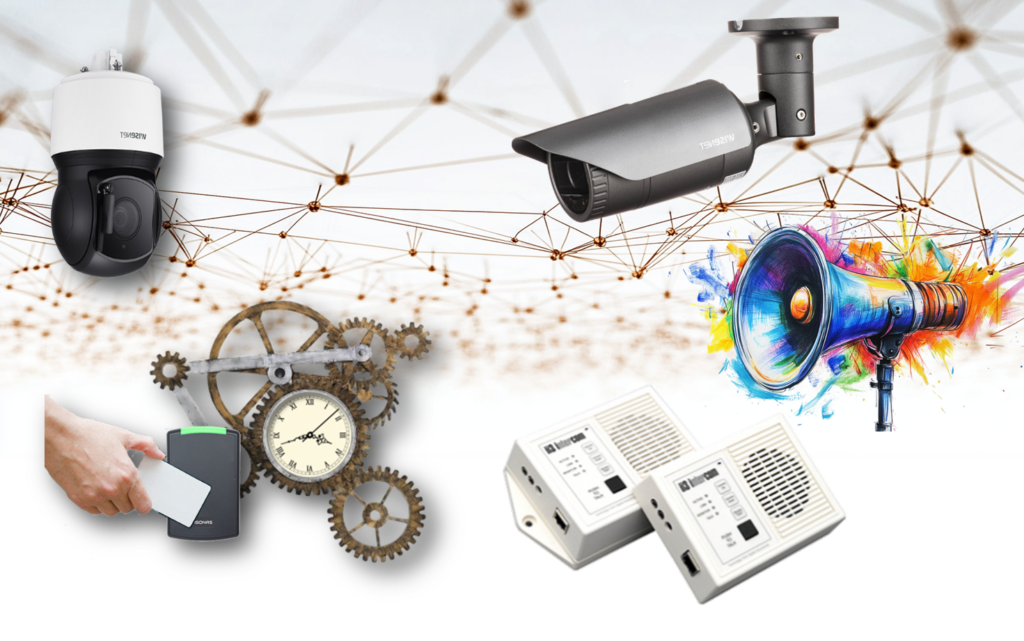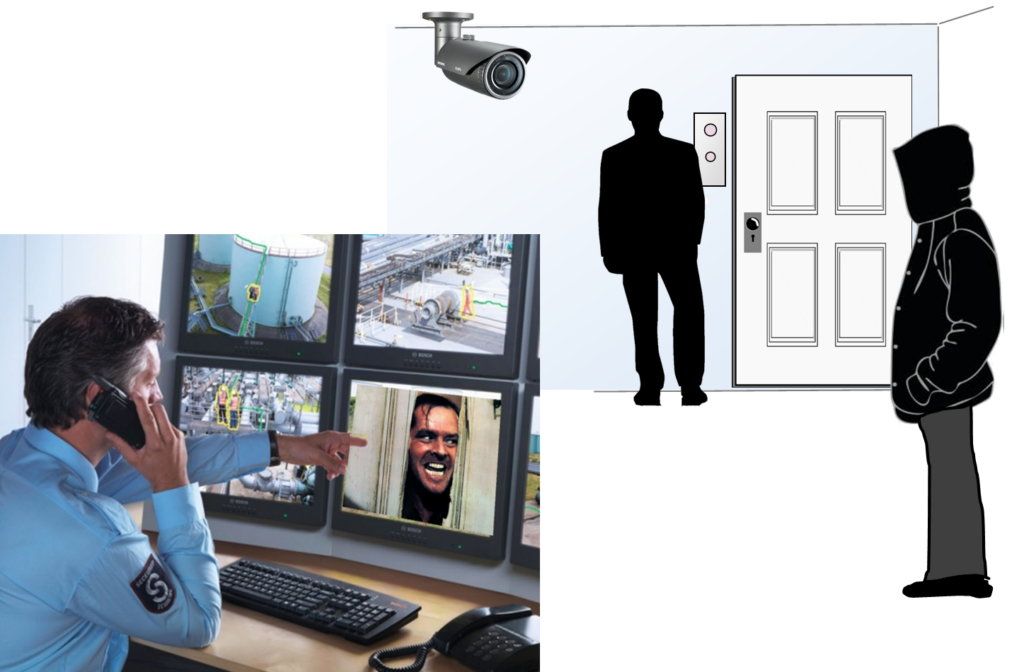Maximizing Physical Security by Integrating Access Control, IP Camera Systems, Intercoms, and IP Paging Systems

Integrating door access control, IP camera systems, intercoms, and IP paging is one of the best ways to create a comprehensive and highly secure physical security system. When these components work together, they provide real-time surveillance, controlled access, seamless communication, and rapid emergency response.
This article describes how to maximize security through integration:
Access Control System: Regulating Entry and Exit
Key Goals:
Restrict unauthorized access, track personnel movements, and integrate with other security measures. Select access control systems that provide instant alerts when a non-authorized credential is used or a black-listed person requests entry.
Best Practices:
- Use Multi-Factor Authentication (MFA) or Biometric Door Readers
- The latest multimodel door readers combine biometric capability with RFID card credentials.
- Utilize Intelligent Cameras
- Use facial and license plate recognition camera systems to detect unauthorized individuals and vehicles.
- Face recognition in a crowd is the latest way to improve security and prevent crimes.
- Set Access Levels
- Grant access based on roles (e.g., employees vs. visitors vs. contractors).
- Select access control that Integrates with Video Surveillance
- Automatically trigger IP cameras to record when a door is accessed.
- Provide real-time video verification of identity.
- Enable Remote Lockdown
- Quickly lock down doors in emergencies using a mobile app or central control.
Integrating Door Access Control with Other Systems:
- Link IP cameras to capture footage when doors are accessed.
- Sync with intercoms to verify visitors before granting access.
- Connect with IP paging to broadcast security alerts during emergencies.
- Integrate with Visitor Management Systems.
IP Camera Systems: Real-Time Surveillance & Analytics

Key Goals:
Monitor high-risk areas, provide evidence for investigations, and deter crime—alert security when threats are detected.
Best Practices:
- Deploy AI-Powered Cameras
- Use AI-enhanced cameras to detect a person carrying a gun, when people are fighting, or if someone falls.
- Ensure that the IP cameras meet your objectives. If a camera needs to capture a person’s face for identification, check that it has the right lens and camera resolution. Learn more: What IP Camera Resolution Do You Need?
- Enable Motion & Behavior Detection
- Set up alerts for suspicious movements (e.g., loitering near secure areas).
- Ensure 24/7 Monitoring
- Use AI-based alerts to notify security personnel of unusual activity in real-time.
Integration with Other Systems:
- Connect IP Camera Systems with Access Control: Capture footage of anyone using an access card.
- Integrate IP cameras with intercoms: Allow security teams to see and talk to visitors before granting entry.
- Trigger IP paging announcements: Alert on-site personnel when suspicious activity is detected.
Intercom Systems: Secure Visitor Management

Key Goals
Verify and securely grant visitors, employees, and delivery personnel access.
Best Practices:
- Install Video Intercoms at Entry Points
- Ensure real-time visitor verification through live two-way video and audio.
- Ensure the intercoms include relay connections that can control the electric lock.
- Use Mobile App Integration
- Allow security personnel to verify visitors remotely.
- Keep Access Logs
- Store audio and video recordings of all visitor interactions.
Integration with Other Systems:
Connect to access control: Grant or deny access remotely.
Sync with IP cameras: Provide a co
IP Paging Systems: Real-Time Alerts & Emergency Notifications

Key Goals:
Broadcast alerts, enhance communication, and guide people during emergencies.
Best Practices:
- Automate Security Announcements
- Link to motion sensors or access control to announce unauthorized access attempts.
- Use Zoning for Custom Messages
- Send messages to specific floors, departments, or areas as needed.
- Enable Emergency Lockdowns
- Sync with access control to secure doors and announce safety procedures instantly.
- Utilize Pre-Recorded & Live Announcements
- Broadcast automated security messages during emergencies.
- Allow security teams to give real-time verbal instructions.
Integration With Other Systems
- Trigger announcements based on security events (e.g., unauthorized access, fire alarms)
- Sync with IP cameras to announce live threats detected by AI analytics.
- Alert staff via mobile devices and security dashboards.
Putting It All Together: A Real-World Example
Scenario: Unauthorized Entry Attempt
A suspicious person tries to enter a restricted area.
The access control system denies entry and triggers the nearest IP camera.
The camera’s AI detects a loitering threat and sends an alert to security.
The intercom system allows the security team to question the individual remotely.
If needed, the IP paging system broadcasts an alert to nearby staff, warning them.
Security teams lock down doors remotely, ensuring the area is secure.
Summary: Maximizing Physical Security
Organizations can achieve real-time threat detection, automated responses, and enhanced security oversight by integrating access control, IP cameras, intercoms, and paging systems. Use a Centralized Security Platform to integrate all systems seamlessly. Leverage AI and Automation to detect threats faster. Conduct Regular System Audits to identify vulnerabilities. Train Staff on Emergency Protocols for effective responses.
If you need help selecting the right security system, please get in touch with us. We are an engineering group that provides consulting on complex system applications. We can be reached at 914-944-3425, visit our website, or use our contact form